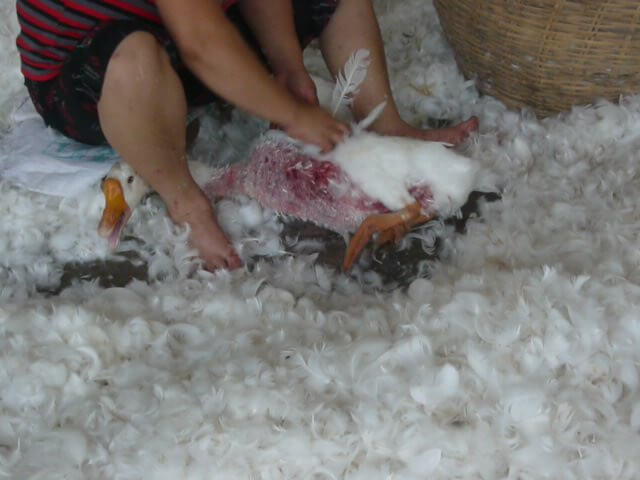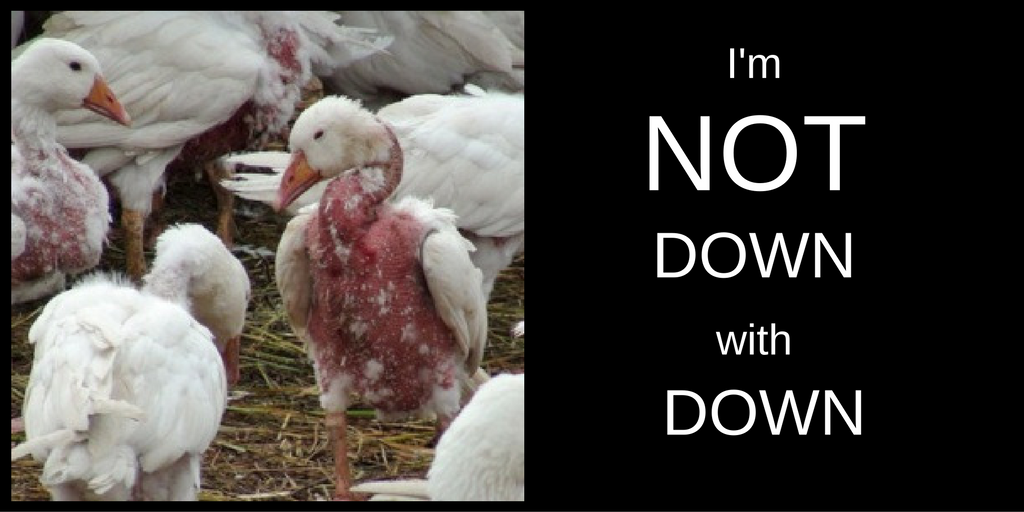Until recently, I hadn’t considered how the down industry works. Those luxuriously warm comfortable jackets, comforters, pillows and sleeping bags have a dark side that is vital to consider before ever buying a product with down again.
What is down? Down is a soft insulating protective layer of feathers between a bird’s skin and the tougher outer feathers. Down is gathered from birds in several ways- gathering, after death, and live plucking. Live plucking is banned in the United States, but up to 80% of the the down used in products we buy comes from live-plucking in China, Hungary, and Poland- and presumably from other countries with unknown oversight. The video below is only a minute long and shows just how that comforter came to be…
The Down Industry is big money with a lot to lose from negative publicity. The truth began to come to light in 2009 when a Swedish documentary exposed that between 50% to 80% of the world’s down was being live-plucked. At the time, IKEA independently verified these numbers and, along with Patagonia, found alternative sources for their down. The “alternative” sources are cruel too, but we will get to that in a minute.
When birds are live-plucked, they are stripped of their feathers by hand, often ripping the skin, while choking and crushing the animals. The poor birds are made to suffer this way up to six times a year. The first live-plucking comes when the birds are a mere 10 months old, still new to the world.

Other Methods?
There is no “good” way of sourcing down. When birds aren’t live-plucked, the down is either procured from geese and ducks who are slaughtered for their meat, or the down is gathered from live birds. “Gathering” might sound nice but the birds are carried, herded, and manhandled in ways that often break their bones, and live-plucking often occurs during the gathering process to increase profits.
Just as leather is sold to supplement the profits of the meat industry, down is sold to boost the profits of the foie gras industry. Even if a label identifies the product as being made in the United States, there is virtually no way to know where, when, or how the down inside was sourced. Wherever it came from, it wasn’t pretty.

Down Alternatives
Everything that you love about down is captured by modern synthetics and natural alternatives. The alternatives include: synthetics (usually polyester fibers layered and intertwined to mimic down’s loftiness), Primaloft, Microcloud, Ingeo (corn fibre), bamboo, cotton, modal, Tencel (eucalyptus fibre), buckwheat husk, Kapok (fibers from the pods of kabok or ceiba trees which require no pesticides or irrigation), and others.
With so many alternatives to down, there is no reason to make animals suffer to stay warm. In today’s world there is no excuse to exchange an animals dignity for comfort, fashion, and whims. Now that I know what what I know, it’s easy to say, “I’m not down with down.”




